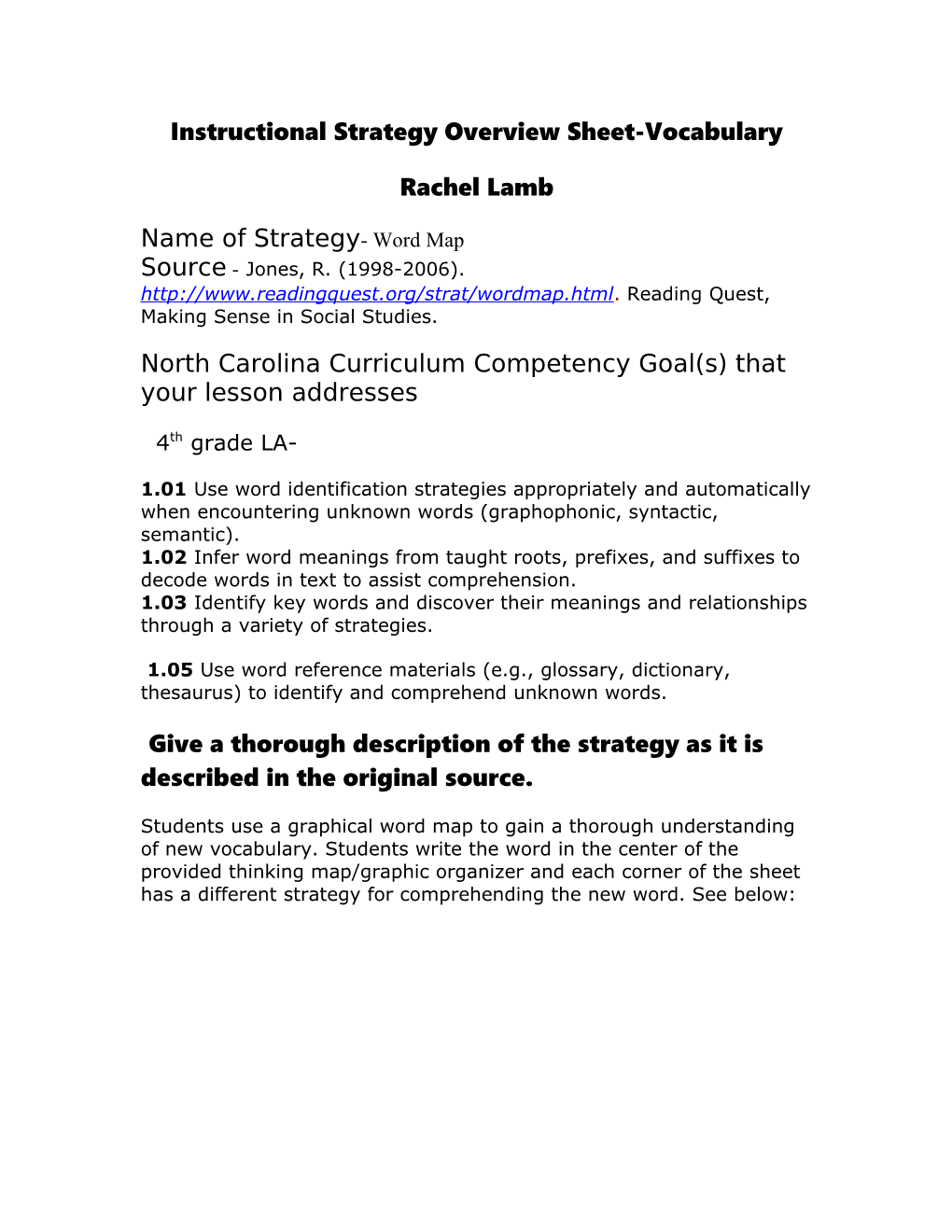Instructional Strategy Overview Sheet-Vocabulary
Rachel Lamb
Name of Strategy- Word Map
Source -Jones, R. (1998-2006). . Reading Quest, Making Sense in Social Studies.
North Carolina Curriculum Competency Goal(s) that your lesson addresses
4th grade LA-
1.01 Use word identification strategies appropriately and automatically when encountering unknown words (graphophonic, syntactic, semantic).
1.02 Infer word meanings from taught roots, prefixes, and suffixes to decode words in text to assist comprehension.
1.03 Identify key words and discover their meanings and relationships through a variety of strategies.
1.05 Use word reference materials (e.g., glossary, dictionary, thesaurus) to identify and comprehend unknown words.
Give a thorough description of the strategy as it is described in the original source.
Students use a graphical word map to gain a thorough understanding of new vocabulary. Students write the word in the center of the provided thinking map/graphic organizer and each corner of the sheet has a different strategy for comprehending the new word. See below:
The original resource provided two versions of the map. I chose the version that is attached to begin with. This strategy was developed to use while reading in the content area, but I thought using it with my lower level students would be ideal.
Describe in detail how it will be implemented.
I will write each of the 5 new vocabulary words on the board. We will predict a definition for each word, discuss where we have heard or seen the words previously.
Next, we will compose a student friendly definition together after I read aloud how the dictionary defines the word. For example, one word is paddock. The dictionary defines this word as a noun meaning
1. / a small, usually enclosed field near a stable or barn for pasturing or exercising animals.2. / the enclosure in which horses are saddled and mounted before a race.
I would provide a picture found on the internet of a paddock and we would compose a definition that the students could understand. “A fenced in area near a stable where horses graze.”
After completing a definition for each word, I will have the students fold a sheet of plain white paper into fourths (rather than making copies of the worksheet). Each section would be labeled and the folds traced over. The first square should be labeled “Definition” the one underneath “Sentence”, the top right square “Synonyms” and the last square “picture” or “What it reminds me of”. The word is written in the middle of the page. We will complete the activity for each of the new words.
Describe how you implemented the strategy. Did you deviate from your original plan?
I wrote each of the 5 new vocabulary words from Sarah, Plain and Tallon the board (paddock, corral, barrel, bluff, and eerie). We shared any prior knowledge students had of a definition for each word, and discussed where we have heard or seen the words previously.
Next, we will composed a student friendly definition together after I read aloud how the dictionary defined the word. For example, one word is paddock. The dictionary defines this word as a noun meaning
1. / a small, usually enclosed field near a stable or barn for pasturing or exercising animals.2. / The enclosure in which horses are saddled and mounted before a race.
I printed pictures by going to google.com and searching images for ach word. I showed a picture found on the Internet of a paddock and we composed a definition that the students could understand. “A fenced in area near a stable where horses graze.” The students wrote the definitions from the board into their reading notebooks. I shared how I see a paddock on the way to school each morning at the RockBarnEquestrianCenter (which most students pass as well). Another word is corral, so I made sure they knew the difference between the two.
After completing a definition for each word, I will had the students fold a sheet of plain white paper into fourths. Each section was labeled and the folds traced over. I held up a sheet and we folded the paper step by step (we call it folding” hamburger” and “hotdog”). I said the first square should be labeled “Definition” the one underneath “Sentence”, the top right square “Synonyms” and the last square “picture” or “What it reminds me of”. The word is to be written in the middle of the page. We will complete the activity for each of the new words.
I found immediately that Synonyms would be difficult for some of the words, so I changed gears and we changed Synonyms to Picture. This way the students had to have a picture representation of the word AND a reminder.
Assess the effectiveness of the strategy. What would you change if you teach it again?
I loved this strategy. I have used it every Monday during my extensive vocabulary lesson. We complete a what we now call “Vocab Box” on any word that is new to the student. I have kept the boxes the way I changed them in the lesson the first day. The preparation is minimal expect finds images of the words. This is something I try to do for all my below grade level students to build onto their sparse schema.
